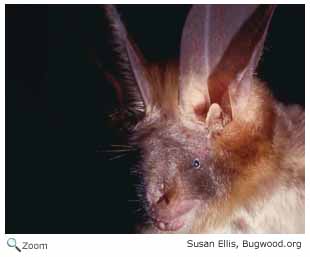Egyptian slit-faced bat
Egyptian slit nose ( Nycteris thebaica )
The Egyptian slit nose ( Nycteris thebaica ) is a species of bat in the family of slit noses, which is native to Africa. The species name refers to the city of Thebes near Luxor in Egypt, where the species was described by the naturalist Étienne Geoffroy Saint- Hilaire for the first time.
Description
The Egyptian slit nose has large, oval-shaped ears, and a name-giving, deep slit in the snout, which is located between two small nose leaves. The tragus in the form of an inverted pear. The tail is included in the tail wing membrane and ends as with other members of this family in a T-shaped cartilage, which supports the tail wing membrane. The coat is generally brighter than the other slit noses, varying between dusty gray and reddish brown. The belly is light gray to white. The fur color varies geographically not, however, been observed that individuals from drier areas are generally brighter. The forearm length is 39.2 to 47.4 mm, wingspan about 30 cm. Males are on average 8.7 g in weight, the weight of the females is 9.8 g
Way of life
Nutrition
The Egyptian slit nose has relatively large, broad wings, which makes it an agile flier. She is like most bats nocturnal and feeds on arthropods. The type is relatively opportunistic. The prey is caught either in flight or collected from leaves and soil. The Egyptian slit nose uses in addition to echolocation calls also noise that is produced by the prey, such as crawling on loose sheets. The preferred prey include grasshoppers, moths and beetles. During the dry season also play caterpillars of butterflies greater importance in the diet of the Egyptian slit nose. In addition, the choice of prey is dependent on the occurrence in the area of distribution, habitat and season. It is assumed that it belongs to the migrating bat species, the vast migrations in purchase to take in order to find suitable food.
Calls
The echolocation calls of the Egyptian slit nose are short (<2 ms), multi- harmonic and of low intensity. If the bat approaches a prey increased the call rate. The calls begin in the frequency range of 97 kHz and then sink to the area around 61 kHz. You are not audible to the human ear. In addition to echolocation produced the Egyptian slit nose two audible for humans call types with a duration of > 40 ms. One of them is in the range from 8.8 to 12.6 kHz and is mainly used in the colonies. The second call starts at 22.1 kHz, 10.1 kHz and drops to then rises again to the output frequency. This call is produced by the bats when they leave the hanging place.
Social behavior
During the day you will find the Egyptian slit nose in artificial structures such as mines, tunnels, bunkers, ruins, fountains and crypts, but also to natural slope in places such as caves, hollow trees, rock crevices, as well as in buildings of aardvarks and in termite mounds. Egyptian slit noses often form colonies of several thousand individuals. In South Africa, one finds the way in caves, often alongside other bats such as Myotis tricolor, the ordinary circular blade leading edge ( Hipposideros caffer ), Rhinolophus simulator, R. clivosus, the Blasius Horseshoe Bat ( Rhinolophus blasii ), and long wing bats ( genus Miniopterus ). In the Democratic Republic of Congo, the Egyptian slot nose divides the hanging place also occasionally with Rhinolophus swinnyi, in East Africa with the Nilflughund ( Rousettus aegyptiacus ) and Taphozous perforatus in Malawi fumigatus with Rhinolophus, in Senegal with the large ear - slit nose ( Nycteris macrotis ) and in Egypt with Asellia tridens.
Reproduction
Egyptian slit noses can become pregnant several times a year in tropical areas, while populations are monoöstrisch in the subtropics and in temperate regions. The females give birth after a gestation period of about five months in temperate regions and between 2.5 and 3 months in tropical areas each being a single young is born. Newborns weigh on average 6.0 g and taken hanging from the females during foraging flights on the teats.
Distribution and habitat
The Egyptian slit nose occurs in many parts of Africa, the Arabian Peninsula and in Israel. They are found in a variety of habitats, such as savannas, woodlands and rainforest. The species is classified by the IUCN as safely.










